Send the Meteor
The Embrace is another example of the artistic incompetence on display in American cities.
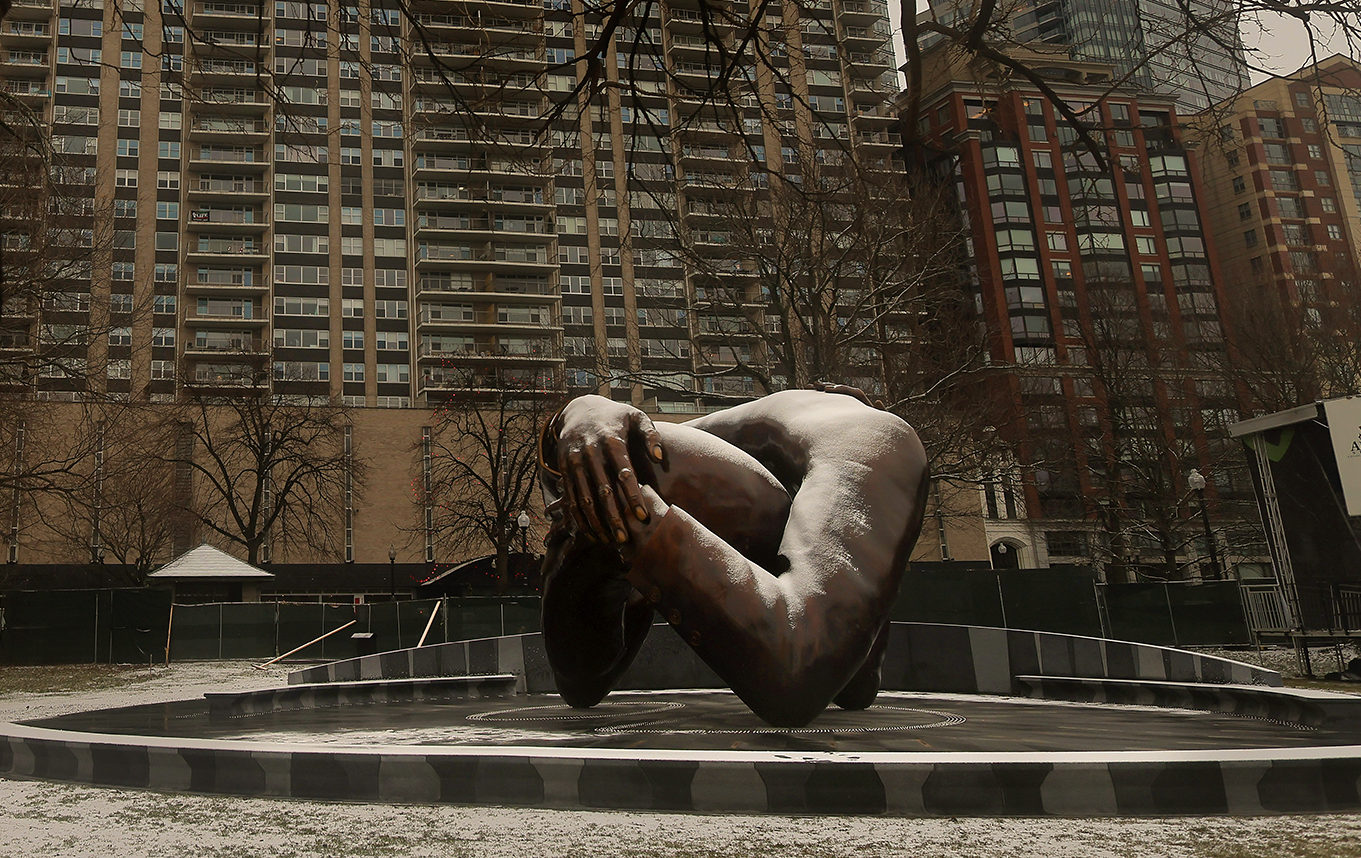
Quid tam elaboratum et distortum!—“What could be so elaborate and contorted?!”—exclaimed Quintilian, the great Roman authority on rhetoric, in pondering the much-copied classical Greek masterwork, the Discus Thrower. Given the athlete’s rotated torso, retracted arms and crossed legs—he is about to fling the projectile—Quintilian’s reaction is perfectly understandable. But if he was startled by this sculptural tour de force, his jaw would surely drop at the sight of The Embrace, the recently unveiled memorial to Dr. Martin Luther King Jr. and his wife, Coretta Scott King, on the Boston Common.
The Discus Thrower is possibly a three-dimensional transformation of a figure originally modeled in relief, and in that case the athlete’s complicated pose would have become much more obvious with his recreation in the round. The Embrace is a three-dimensional reworking in bronze of a photograph of the Kings hugging one another upon receiving the news, in 1964, that Dr. King had been awarded the Nobel Peace Prize. The photo shows King’s hands clasped on Coretta’s left shoulder. From it the memorial’s creator, Hank Willis Thomas, extracted their arms and hands—clothing, wedding rings and Coretta’s bracelet (actually a watch band in the photo) included.
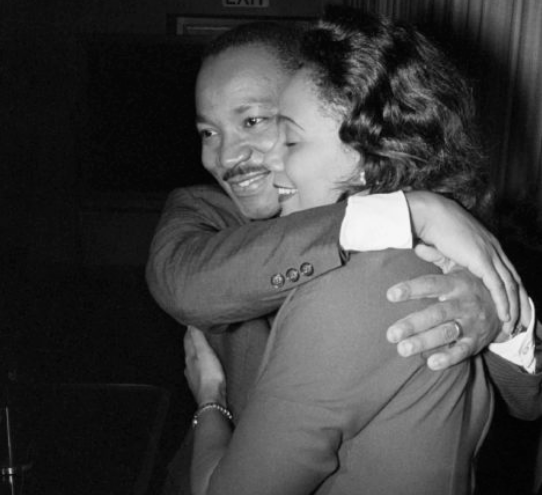
All that’s missing are their heads and torsos. Such “an intertwining of disembodied arms,” the distinguished architectural historian James Stevens Curl noted in a recent TAC piece about the new memorial, “induces a sense of deep unease, almost of creepiness.” In sum, The Embrace is a twenty-foot-tall, twenty-ton lemon.
In the photo, Coretta’s left hand is pressed against King’s back. In the sculpture, King has no back, so that hand is cupping his shoulder, while her right hand, which is invisible in the photo, appears to be tugging him downward. Both her elbows are perched on the ground, while only one of her husband’s is.
“I wanted to make something that really talked about love. I saw in that moment [captured in the photo], how much of his weight was literally on top of her,” Thomas told a Boston audience last year. He took that to be “symbolic” of wives like Coretta “carry[ing] the burden of the man who was getting the award.” Others have read the resulting memorial very differently, however. After its unveiling on January 13, Leslie Jones, a black comedienne and Saturday Night Live veteran, put “white people” on notice in a guest appearance as Comedy Central’s anchor: “This is our civil rights icon. Going down on his wife. You show some damn respect.”
The somewhat amorphous and inevitably distorted modeling of King’s arms and neckless shoulders have themselves inspired indecent thoughts, reminding Twitter commentators of the male member or turds. “Jesus, send the meteor,” implored one of the memorial’s more civil detractors, while a latter-day Quintilian fumed, “Why’d you make it so complicated and confusing?”
Situated in a circular plaza on the Common, The Embrace is not the work of a sculptor. Thomas (b. 1976) is a black photographer and graphic designer who often works with racial themes. The new plaza’s granite pavement is laid in a diamond-shaped pattern intended to reference African-American quilts. One of its two curvilinear bench walls is inscribed with a quotation from Coretta King—it starts with the words “Love is such a powerful force. It’s there for everyone to embrace...”—while a bronze plaque commemorates dozens of local civil rights activists. In 1965, King addressed a crowd from the Parkman Bandstand (1912), a beautiful open-air, circular temple close to the new memorial after leading a march from Roxbury to the Common. (For the record, King had lived in Boston for three years while pursuing a doctorate in systematic theology from Boston University. It was there that he met his future wife, who was studying voice at the New England Conservatory of Music.)
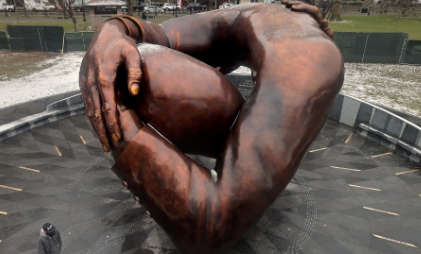
The Embrace’s plaza is the work of MASS Design Group. Thomas and MASS have also collaborated at the National Memorial to Peace and Justice in Montgomery, Alabama—commonly known as the “lynching memorial”—and on the Gun Violence Memorial Project, a postmodern installation currently on view at the National Building Museum in Washington.
Thomas, whose work can be found in important museum collections, is often referred to as a “conceptual artist.” Those two words are quite arguably oxymoronic, and not only in Thomas’s case. One of his métiers, elucidated in a Wall Street Journal magazine profile last fall, is infusing recreations of abstract works by modernist painters like Ellsworth Kelly and Roy Lichtenstein with politically-charged photographic images whose visibility depends on lighting and one’s angle of vision. Thomas’s take is that he is supplying content to fill out the celebrated modernists’ formal styles. But what he is really doing is engaging in pastiche. Somewhat more refined is his appropriation of the veiled heads of Magritte’s two kissing lovers in a double bust of shiny stainless steel. Far more problematic, however, is Thomas’s appropriation of photographs documenting civil unrest in South Africa during the apartheid era, taken by two living South African photojournalists whose labors entailed considerable personal risk. “Making art” of two such photos essentially amounted to highlighting particular figures by casting a ghostly fade on the rest of the images. “I feel like it’s a dangerous moment when we start to tell people what they can and cannot talk about, what they can and cannot focus on, when they’re making art,” Thomas told CBS News in 2018 in responding to the photojournalists’ outrage. “[...] Censorship is part of the incredible tools of the apartheid government, you know, and any oppressive regime.”
Come again?
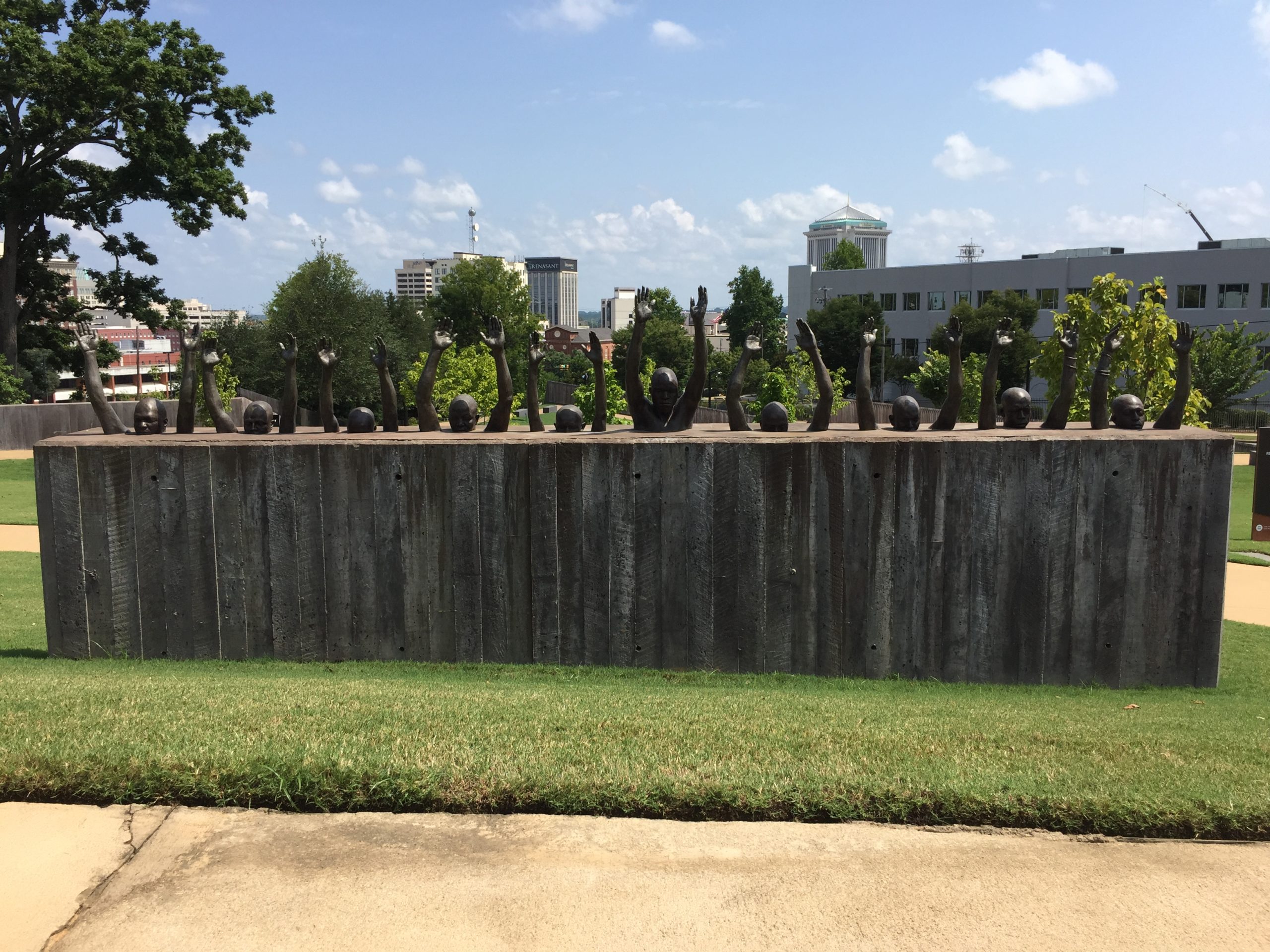
On the grounds of the lynching memorial, a pavilion featuring hundreds of suspended blocks of rusting COR-TEN steel inscribed with names of counties where lynchings occurred as well as the names of the victims and the dates of their murders, Thomas’s Raise Up (2016), a row of ten black figures with their arms raised, has been installed. The figures, apart from their heads and arms, are submerged in a concrete block. Intended, as a nearby plaque indicates, to reference systemic racism in the nation’s criminal justice system, the figures were derived from a photograph by Ernest Cole (1940-1990), South Africa’s first black photojournalist, of South African miners stripped naked for medical examination. “Cultural appropriation” is of course a favorite howl of the woke grievance industry, but the issue doesn’t seem to have made a dent in Thomas’s career.
At least The Embrace is not an overtly politicized work. Thomas has emphasized the importance of the emotional impact of standing within the memorial, where visitors “will be in the heart of the embrace,” gazing skyward through the opening left by shoulders and arms. But the truth is that a work of art must be self-consistent, so that its components contribute to a formally unified whole that achieves an emotionally resonant effect. The Embrace is just too bizarre to cast that kind of spell.
It also raises the question of sculpture’s current status as an art. It seems entirely possible that no modeling—as opposed to finishing—by hand was involved in the creation of Thomas’s memorial. Again, he was trained as a photographer, not a sculptor. In that case, three-dimensional photographic scans could have been taken from live models, from which scans the desired forms were digitally extracted and configured for fabrication, via 3-D printing, of a model. A model was definitely scaled up for 3-D printing of over 600 pieces, which were then cast in bronze and assembled at a foundry in Washington state. Having been cut into nine large sections, the sculpture was trucked across the country for final assembly at the memorial site. A photograph on Willis’s Web site page devoted to The Embrace shows a reduced-scale model in front of the bronze sculpture. The former appears to be printed rather than cast.
One might wonder what became of homo faber. It must be admitted, however, that traditional sculptural methods by no means automatically lead to impressive results. In 2011, a colossal, 30-foot-tall portrait of King in three-quarter relief was unveiled alongside Washington’s Tidal Basin, facing the Jefferson Memorial. The relief, carved out of a slab of beige granite dubbed “The Stone of Hope,” is the work of Chinese sculptor Lei Yixin, a creature of the PRC’s official monuments industry. Lei worked up a full-scale plaster model of his portrait.
The Stone is extruded from the middle of the memorial’s “Mountain of Despair,” itself hewed from the same titanic mass of Chinese granite. The memorial’s Stone and Mountain comprise a lamentable reification of a figure of speech from King’s “I Have a Dream” speech, delivered at the Lincoln Memorial in 1963. It did not escape notice while the King memorial’s design was under review that Lei’s technique was better suited to portrayal of the likes of Lenin or Saddam Hussein. Nor did the fact that he had proved incapable of modeling King’s ethnographic features properly. Washington’s King memorial is an exercise in pseudo-monumental kitsch. And the failure of the Boston and Washington memorials to pay due tribute to a pivotal figure in American history is another sad commentary on our deracinated culture.
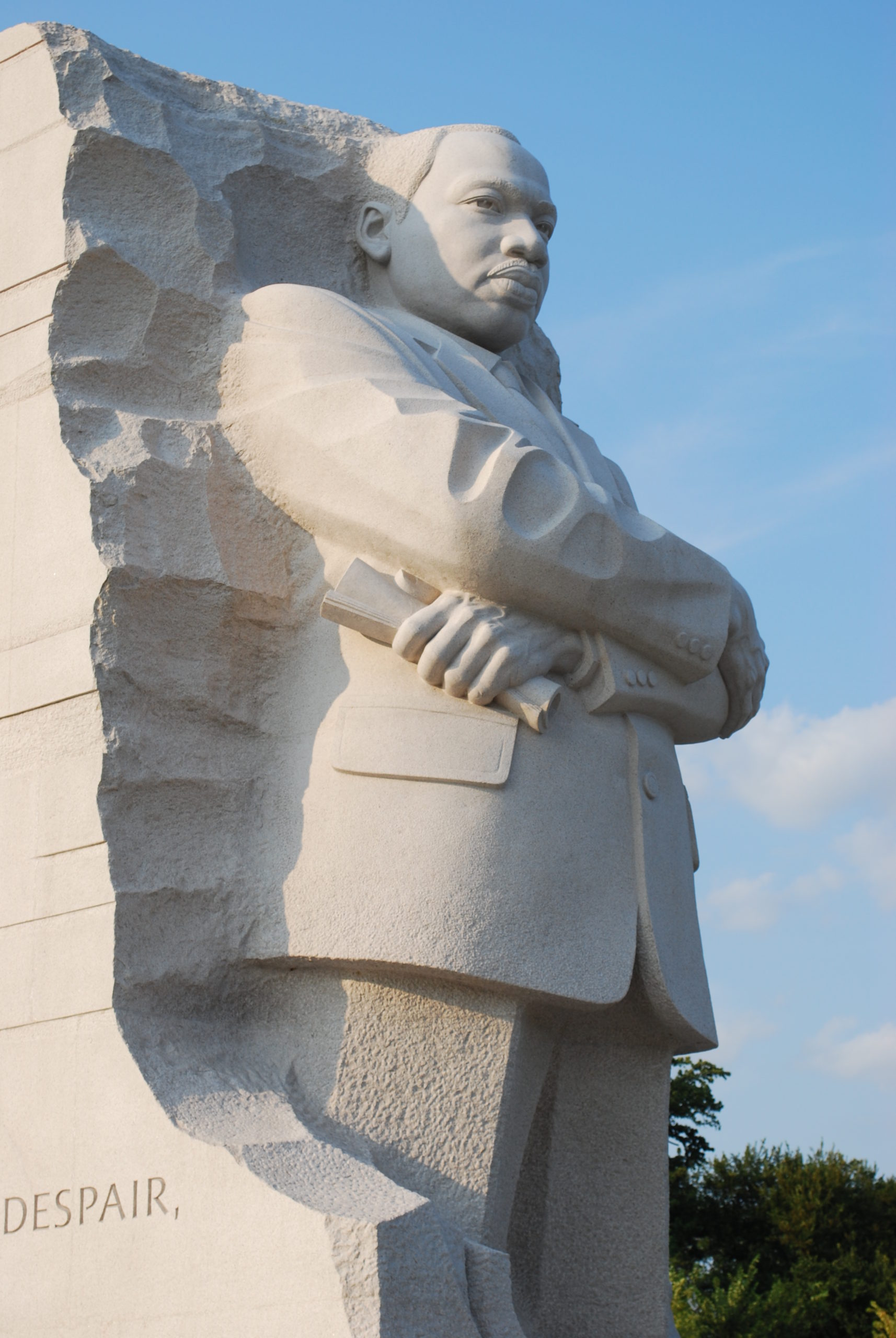
The work of Thomas and MASS is closely aligned with the politics of Black Lives Matter, not least at the lynching memorial—the white-guilt memorial par excellence. Thomas is also a co-founder of For Freedoms, which describes itself as “an artist collective that centers art and creativity as a catalyst for transformative connection and collective liberation.” Backers include the now-woke Andrew W. Mellon Foundation along with George Soros’s Open Society Foundations and scores of academic institutions, museums, and artsy outfits.
For Freedoms—the name, of course, is a play on FDR’s famous 1941 speech, as well as Norman Rockwell’s paintings illustrating it—is known, among other things, for agitprop in the form of banners and billboards. On the newly created holiday of Juneteenth, 2020, Thomas’s huge banner, reading “All Li es [sic] Matter,” was unveiled on a facade of the Human Rights Campaign’s headquarters in downtown Washington. (The HRC lobbies for gay and transgender rights.) The banner was Thomas’s reply to objections to the BLM slogan. Also noteworthy is a billboard that For Freedoms posted in Pearl, Mississippi, across the river from the state capital of Jackson, during the 2016 presidential campaign. The words “Make America Great Again” were superimposed on Spider Martin’s grim 1965 photo, Two Minute Warning, of state troopers confronting civil rights marchers in Selma, Alabama, moments before they violently assaulted them.
The city is the principal theater in which a civilization symbolizes itself. And as our nation’s cities increasingly fall under the sway of the politically and culturally woke, it behooves us to ponder the prospect of the American public realm being subjected to increasingly toxic levels of artistic incompetence as well as political correctness. “I think public art is propaganda, frankly,” Thomas told the Art Newspaper in 2019. He presumably harbored the forlorn hope of conveying a deeper message with The Embrace, but the quote should be taken for a warning. Thomas and his collaborators at MASS explicitly favor the sweeping away of commemorative works at odds with current orthodoxies and their replacement with public art that caters to them. With the advent of The Embrace, MASS avers on its Web site,
The city [of Boston] is answering the call asked by many across the country: how can we fill the voids left in America’s public spaces, once we have removed the memorials that divide us? How can we demand more memorials that unite us around our common humanity, love, and empathy?
Beware the woke wolf in sheep’s clothing. In a commentary for CNN Style posted while the Black Lives Matter riots were underway, Thomas suggested that “[i]nstead of celebrating grand, straightforward narratives, we should acknowledge the complexity of particular moments.” Would Thomas allow such critical distance to be taken with regard to the Confederate Memorial at Arlington National Cemetery? Plenty of complexity can be gleaned from the “particular moment” of its creation. Would he make allowance for consideration of that memorial’s artistic quality, which puts his own oeuvre to shame? Most unlikely. At least Thomas raised the question, while work on The Embrace was underway, whether his memorial would be “important” 100 years from now, and when it should be subject to “review,” meaning reconsideration. Obviously, the latter can’t come too soon.
Subscribe Today
Get daily emails in your inbox
Otherwise, we’ll just have to pray for that meteor.
This New Urbanism series is supported by the Richard H. Driehaus Foundation. Follow New Urbs on Twitter for a feed dedicated to TAC’s coverage of cities, urbanism, and place.
Editor's Note: An earlier version of this essay mistakenly attributed the design of the Enslaved Laborers Memorial at the University of Virginia to MASS. It was designed by Höweler + Yoon. We regret the error.
Comments